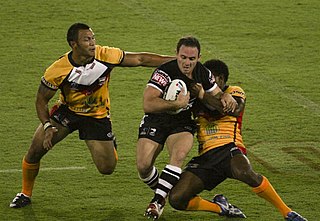Related Research Articles

Rugby union, commonly known simply as rugby, is a full-contact team sport that originated in England in the first half of the 19th century. One of the two codes of rugby football, it is based on running with the ball in hand. In its most common form, a game is played between two teams of 15 players each, using an oval-shaped ball on a rectangular field called a pitch. The field has H-shaped goalposts at both ends.

Rugby league football, often referred to as simply Rugby league, is a full-contact sport played by two teams of thirteen players on a rectangular field measuring 68 metres wide and 112–122 metres long. One of the two codes of rugby football, it originated in Northern England in 1895 as a split from the Rugby Football Union over the issue of payments to the players. Its rules progressively changed with the aim of producing a faster, more entertaining game for spectators.

Neil Antony Back MBE is a former international rugby union footballer for England and the British & Irish Lions who also played for Nottingham RFC, Leicester Tigers, and captained both England and Leicester during his career.

In the game of rugby union, there are 15 players on each team, comprising eight forwards and seven backs. In addition, there may be up to eight replacement players "on the bench", numbered 16–23. Players are not restricted to a single position, although they generally specialise in just one or two that suit their skills and body types. Players that play multiple positions are called "utility players".
A rugby league team consists of thirteen players on the field, with 4 substitutes on the bench. Each of the thirteen players is assigned a position, normally with a standardised number, which reflects their role in attack and defence, although players can take up any position at any time.

Five-eighth or Stand-off is one of the positions in a rugby league football team. Wearing jersey number 6, this player is one of the two half backs in a team, partnering the scrum-half. Sometimes known as the pivot or second receiver, in a traditional attacking 'back-line' play, the five-eighth would receive the ball from the scrum half, who is the first receiver of the ball from the dummy-half or hooker following a tackle.
Robert Dennis "Bobbie" Goulding, also known by the nickname of "Bobbie Dazzler", is an English former professional rugby league footballer, and coach, who played in the 1980s, 1990s, 2000s and 2010s, and has coached in the 2000s and 2010s.
The team sports rugby union and rugby league have shared origins and thus many similarities.

Francis Bede Smith, known as "Frank" or "Bede", was an Australian rugby union player who competed in the 1908 Summer Olympics. Smith, a centre, was born in Wellington, New South Wales and claimed a total of 4 international rugby caps for Australia. His debut game was against New Zealand, at Dunedin, on 2 September 1905.
Bryan Desmond Hughes MC was an Australian soldier and international rugby union player. He was one of a number of Australian rugby internationals who were killed during the First World War.

Hooker is one of the positions in a rugby league football team. Usually wearing jersey or shirt number 9, the hooker is one of the team's forwards. During scrums the hooker plays in the front row, and the position's name comes from their role of 'hooking' or 'raking' the ball back with the foot. For this reason the hooker is sometimes referred to in Australia as the rake.
Francis Cuthbert "Frank" Futter was a rugby union player who represented Australia.
Edward Francis Mandible was an Australia national representative rugby union fly-half and one of the pioneers who broke away from that code to take up rugby league in Sydney in 1910.
Eric Francis was a rugby union player who represented Australia.
Francis Wallace Meagher was a rugby union player who represented Australia.
John Wylie P. Breckenridge was a rugby union player who represented Australia.
Harold Francis Woods was a rugby union player who represented Australia.
Colin Francis Forbes was a rugby union player who represented Australia.
Peter Francis Ryan was a rugby union player who represented Australia.